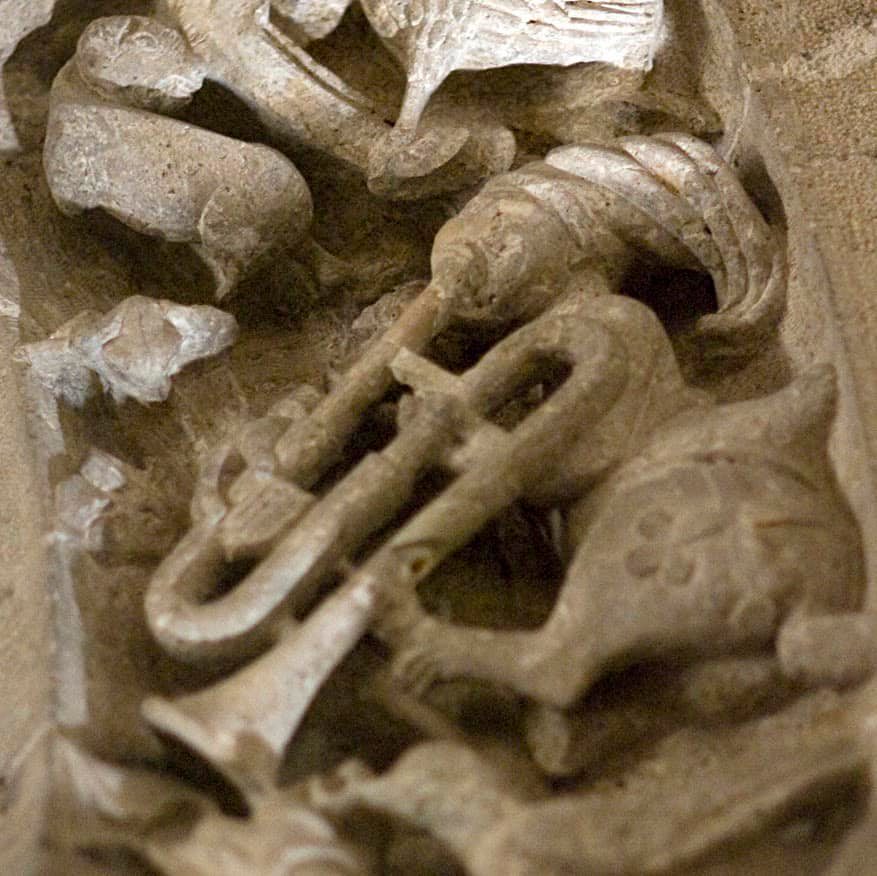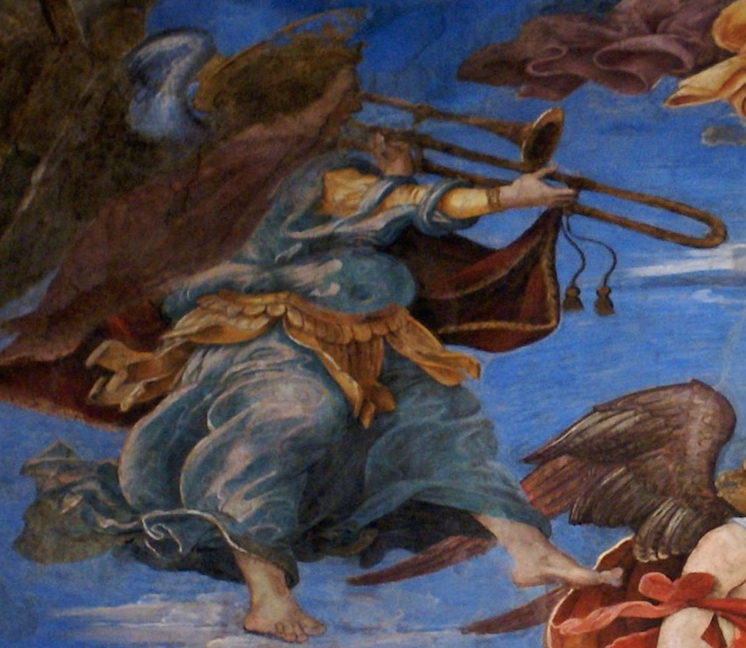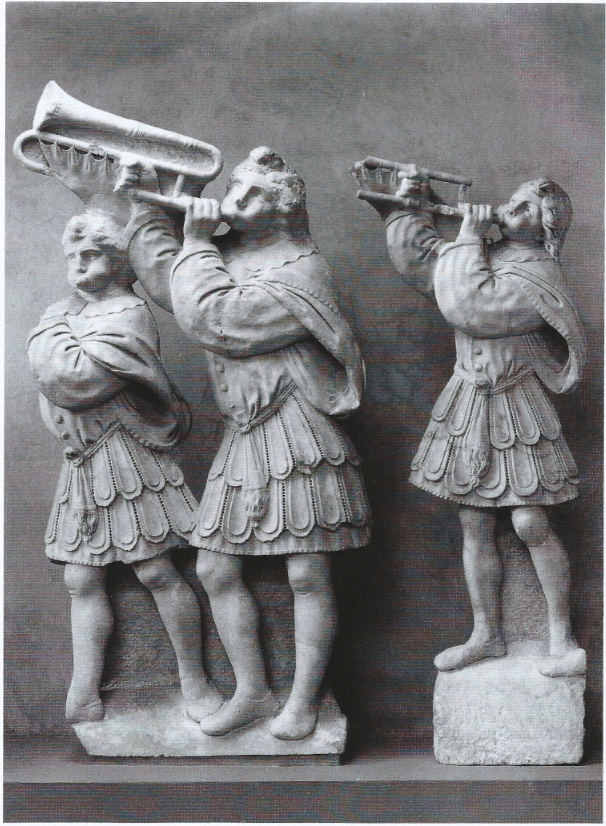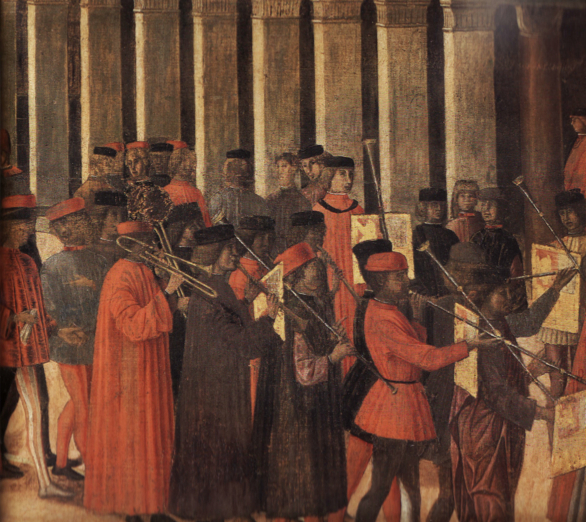15th Century—During this century the trumpet and horn existed, but they were considered functional, non-musical instruments.
1401-13—the earliest known S-shaped trumpet was developed, which was later followed by the folded trumpet and slide trumpet.
c. 1404—France: Grotesque with S-shaped trumpet. Marginal decoration from The Hours of Charles the Noble (Cleveland Museum of Art). See below; public domain.
1407—Siena, Italy: German musician Angelo d’Arrigo joins the Palace trumpeters as a player of tuba grossa. There is speculation that this term, tuba grossa (Latin: large trumpet), could be a scribe’s best effort at describing a trombone, which would have been a very new instrument at the time (D’Accone, Civic Muse 443, 517).
1418—Paris, France: Among musicians listed in the service of Charles VI is a trompete pour menestrier (as distinct from “war trumpet”), possibly an early term referring to trombone (Perkins, Musical Patronage).
1421—Nuremberg, Germany: Accounts indicate that musicians of the court of Margrave of Brandenburg include a 4-part shawm band with trombones (posaunen). The musicians in the account are referred to separately: first, 2 trumpets (“2g…trummetern”), then a 4-part shawm band with trombone (“4 g. markgraf Fridrichs pusaunern und pfeiffern”). Thus, according to historian Keith Polk, “This document carries particular authority with its reference to both ‘trummeten’ and ‘posaunen’” (Polk, German 66).
1425-1430—Arras, France: Boar and Bear Hunt and Deer Hunt from The Devonshire Hunting Tapestries (Victoria & Albert Museum; see details below; public domain). The tapestries, likely made in Arras, France, probably belonged to the Countess of Shrewsbury (England), who had the grand Derbyshire house Hardwick Hall built in the 1590s; the tapestries hung at Hardwick until the 19th century.

1426-1438—France: November; deer hunting, from the Hours of Marguerite d’Orleans (see detail below; public domain).
1439—Ferrara, Italy: The earliest known reference to the word trombone is made, applying the Italian suffix one (large) to tromba(trumpet). The document mentions a “tuba ductili…trombonus vulgo dictus” (Polk, Archival Documents; Kurtzman, Trombe).
1444—Florence, Italy: A scribe, apparently struggling to find a name for a relatively new instrument in the court shawm band, calls the trombone a “tortuous trumpet” (tube tortuose—literally having repeated twists or bends). In another document he terms it a tuba retorta, and finally, a tuba grossa e torta (Polk, Epilogue).
1444—Regensburg, Germany: Master of the Polling Panels, Prince Tassilo Rides to Hunting. Originally created for the church of St. John the Baptist in the city of Regensburg, Germany; transferred to German National Museum in Nuremberg in the 19th century (see below; public domain).
1445—Florence, Italy: An account describes the trombone as “trombon grosso…che e tromba torta” (a “large trombone…that is a twisted trumpet”) (Polk, Foreign 326; Polk, Archival Documents).
1446—Siena, Italy: City officials elect to form a Palace wind band, or pifferi, and send the following invitation to Maestro Garino of Avignon: “Esteemed friend! Having learned of your talents and of your mastery of wind instruments, and desirous of having you in our service, we have, together with our colleagues, nominated you and two other pifferi and a trombone, whom you will choose, for a lifetime [appointment in our Palace], at the salary which will be appended here in the hand of our government’s notary. Thus, if you decide to enter our service at that salary, we ask that you bring two good pifferi and a trombone with you and that you come to Siena as soon as you possibly can. You will be welcomed warmly and will be treated so well by us that you will praise our city to the skies.” The salary offered is comparable to salaries in Florence and twice that of the Palace trumpeters, and the invitation is accepted (D’Accone, Civic Muse 522).
1446—Siena, Italy: A document identifies the word trombone as an Italian version of the Latin augmentative tubicinone (D’Accone, Civic Muse 517). Specifically, the priors (city rulers) decide that a person who plays “a large trumpet, commonly called a trombone” can have a lifetime appointment at the Palace (D’Accone, Civic Muse 522).
1449—Siena, Italy: A group of musicians from Florence performs for Assumption Day festivities. The group includes 6 trumpeters, a trombonist, and a herald (D’Accone, Civic Muse 687).
c. 1450—Upper Rhineland, Germany: Trumpeter of Hungary from The Courtly Household Cards, a luxury deck of cards that once belonged to Archduke Ferdinand Il of Austria (brother of Emperor Maximilian Il) and was kept in the Kunstkammer he created at Schloß Ambras, near Innsbruck (Kunsthistorisches Museum Wien). See below; public domain.
c. 1450—The trombone developed out of the slide trumpet, referred to as the sackbut in English, posaune in German, and trombone in Italian. The trombone revolutionized brass instruments by allowing for chromatic performance.
c. 1450—Florence, Italy: Lo Scheggia, Adimari Wedding Cassone (or spalliera). Depicted are a slide trumpet or proto-trombone and 3 shawms. Florence, Accademia di Belli Arti. See detail and full image below.


1450—Lucca, Italy: Several trumpeters and a trombonist from Lucca visit Siena for August festivities (D’Accone, Civic Muse 525).
1450-1460—France: Buisine player and religious figure, Manuscript of Saint-Esprit. Collection of the Carmelite Convent, Dijon, France. See below; public domain.
1455—Siena, Italy: The priors (city rulers) appoint a new trombonist, Arrigo di Giovanni da Francoforte, at the relatively high salary of L. 16 per month. By contrast, Santi di Pavolo enters palace service the same year as a trumpeter at the considerably lower salary of Fl. 2. This trumpet player moves to the pifferi (civic wind band) a few years later as a trombonist and receives a considerable raise (to L. 14 per month) (D’Accone, Civic Muse 529, 534).
1455—(after this date), attributed to Master of Girart de Roussillon, 2 details from The Book of King Modus and Queen Ratio, a treatise on hunting (Royal Library of Belgium, see below; public domain).


1456—Ferrara, Italy: Duke Borso d’Este maintains a musical household of one trombone, 5 trumpets, 2 shawms, 5 keyboards and strings, and one singer (Whitwell, Before 199). The wind band, a subset of this group, consists of 2 shawms and a trombone. The trombonist, a player by the name of Agostino, earns a yearly salary comparable to trumpeters and other musicians of court (Lockwood 178).
1456—Siena, Italy: A group of musicians from Florence, Italy performs for Assumption Day festivities. They include 4 trumpeters, a shawmist, 4 pifferi, and a trombonist (D’Accone, Civic Muse 688).
1458—Nuremberg, Germany: The Duke of Saxony visits Nuremberg, bringing with him the following musicians: “4 trummeters, 3 pfeiffer und 2 posaunen.” Historian Keith Polk points out that these musicians likely comprise two different ensembles: “one a band of four natural trumpets, the other a shawm band consisting of three shawms and two trombones” (Polk, German 59).
c. 1460—France: Jean Fouquet, Banquet in Honor of Emperor Charles IV from Les Grandes Chroniques de France (see below; public domain).
1460—Italy: A group of musicians from Florence performs for Assumption Day festivities in Siena. Included are 11 trumpeters, a percussionist, 3 players of wind instruments, and a trombonist (uno trombone) (D’Accone, Civic Muse 688).
1463—Siena, Italy: A former Palace trumpeter named Santi di Pavolo da Volterra is hired as trombonist with the Siena civic wind band. His new salary is L. 14, significantly higher than his trumpeter’s salary of L. 8.4 (D’Accone, Civic Muse 536).
1463—Siena, Italy: A letter from the Palace wind band members to the Concistoro requests an indirect salary raise: “To our Magnificent and most powerful lords a humble supplication on behalf of your faithful servants, the pifferi and trombone, who having considered their great poverty and misery, and the necessity of providing for their poor families, and having seen that they have no earnings nor provision other than the one they receive from this magnificent Palace, and aware that they have left their own countries and all paternal affection so that they might serve your hallowed Palace, in the service of which they wish always to live and die, beg that it please your most clement lordships to remove the tax [on their salaries], and the portion that has been imposed for the tower that is to be built, [just] as your lordships have deigned to exempt your ushers.” (Despite their claim of “great poverty and misery,” the wind band musicians are relatively well off for their time. Records show, for example, that they are paid better than the palace trumpeters, and many of them own their own homes and vineyards) (D’Accone, Civic Muse 532, 541).
1464—Cologne, Germany: Master of the Lyversberg Passion, Coronation of the Virgin. Depicted is a slide trumpet or proto-trombone (see detail and full image below; public domain).


c. 1465—France: An anonymous illustration in Pierre Michault’s La Dance aux aveugles includes what may be a trombone. A related passage from the manuscript says, “From her [Fortune’s] manner she seemed really to be unsettled, or at least unsteady, and also her eyes were blindfolded like the god Cupid. In her right hand she had a royal scepter, and at her left was a wheel, turning continually. On a tall pillar next to her throne there was a man very richly dressed, who had in his hand a silver trumpet [trompete d’argent], which he sounded frequently. And at the foot of the throne there was another man, miserably dressed, who had also a trompette, but this one was made of wood and in a very old style, and it had already seen such long service that it was all used up and broken, though it had been repaired in many places with small cords. With the sound of their trompes these minstrels assembled [the dancers] and had them dance in the presence of their Lady, like many people I have seen in Cupid’s gardens.” The artist of the related illustration may have confused the two instruments described in the manuscript, particularly in light of which one appears to be metal and which is wood (see detail and full image below; public domain).
1467—Nördlingen, Germany: A visiting ensemble called Count Palantine performs with what a local scribe indicates as 3 pfeifers and a trumpet. However, at a performance by the same players in Nuremberg that year, a scribe describes the instrumentation as “three pfeifers and a posaune.” This highlights the elusiveness of terminology in the early years of the trombone’s existence; the instrument is called, depending on context and location, trombone, trumpet, trompette de ménestrels, posaune, sackbut, and various permutations of those terms (Polk, Archival Documents).
1468-1470—France: Loyset Liédet (d. 1478), Basse dance. From History of Renaud de Montauban. Paris, Bibliothèque de l’Arsenal. See below; public domain.
c. 1470—Memmingen, Germany: Fresco of angel musician in Evangelische Stadtpfarrkirche Unser Frauen (see below; public domain).
c. 1474—Asciano, Italy: Matteo di Giovanni’s The Assumption of the Virgin, the center panel of an altarpiece in S. Agostino, includes what may be an angel-trombonist along with several other angel-musicians. The instrument has what appears to be a slide but no visible bell (see detail and full image below; public domain) (Belán 111). Click on full image to expand.
According to the paintings conservator at the National Gallery in London, below is the angel-musician in its pre-restoration form, a restoration necessitated by water damage. The gilded halo and surrounding area is also non original. According to the conservator (pers. comms., May and September 2024), the painting is now undergoing another conservation treatment.
1480—Belgium: Hans Memling (c. 1433-1494), Angel Musicians (part of Christ with Singing and Music-Making Angels).
c. 1480s—Bruges, Belgium: Master of the White Inscriptions/Master of the Getty Froissart (Flemish, active 1480s), Louis of Anjou Entering Paris (see below; public domain).
c. 1482-1497—Valencia, Spain: A sculpture of a beast playing a proto-trombone is featured among numerous fantastic sculptures in the Contract Hall of the Llotja de la Seda (Lonja de la Seda), a civic building in Valencia’s historical center. Although the instrument’s slide does not extend beyond the bell, the back bow of tubing does extend to the player’s shoulder (see below image; special thanks to Elies Hernandis Oltra).
1488-93—Rome, Italy: In the Carafa Chapel of the church of Santa Maria sopra Minerva, the earliest reliable visual depiction of a trombone is painted: a fresco by Filippino Lippi entitled The Assumption of the Virgin (see detail and full image below; click on full image to expand; public domain) (Kurtzman, Trombe; Herbert, Susato 118; Partridge 118; Goldner 73).
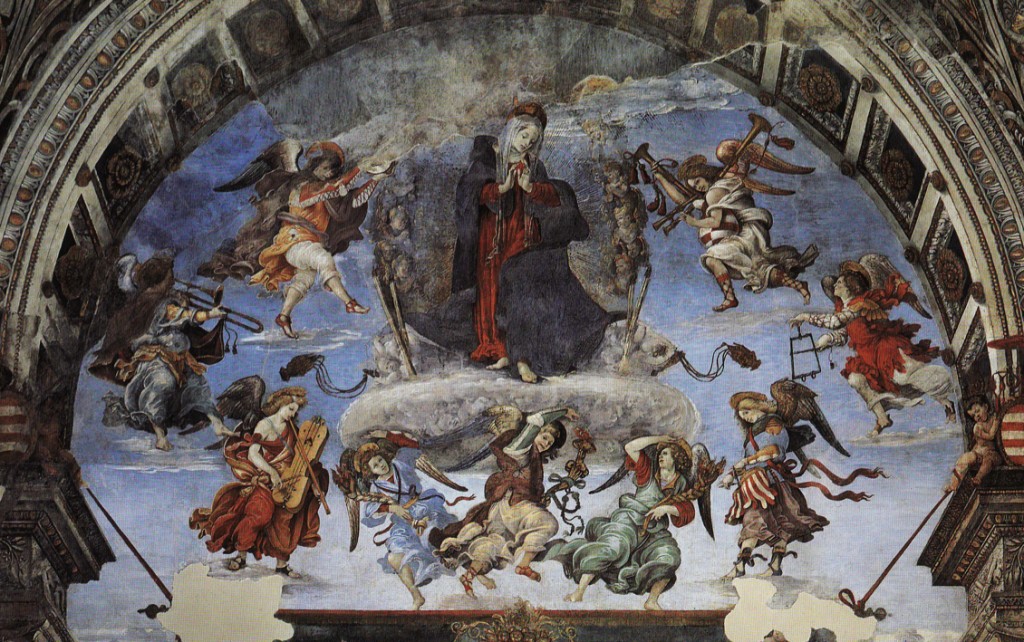
1488—Heidelberger, Germany: (by this date) illustration from Heidelberger Totentanz (see below; public domain).
1489—Germany: Martin Schongauer, The Mystic Hunt of the Unicorn (see below; public domain).
c. 1490—Belgium, Book of Hours, MS S.7 fol. 20v (see below; public domain).
1493—Master of Frankfurt, detail from Festival of the Archers (see below; public domain). Special thanks to Alexandre Mainz.
1494-97—Italy: Benedetto da Maiano’s high relief marble sculpture, The Coronation of Alfonso II, features what are probably 3 trombone players. Although the sculpture is badly damaged, a full trombone is visible in the hands of one of the brass players, and the embouchure and grip of another player are clearly visible. Noteworthy aspects of the rendering include the non-underhand left-hand grip of the 2 players, the relatively small size of the trombone (cf. Bellini detail—1496, below), and the banners apparently attached to the slides (cf. Aldegrever—1538 and Anonymous Nuremberg—c. 1550, 16th century) (see below; public domain) (Carl, Benedetto da Maiano 1:359). The sculpture is now held in Florence’s Museo Nazionale Bargello.
c. 1495-1510—South Netherlands: A tapestry, Vanity Sounds the Horn and Ignorance Unleashes the Hounds Overconfidence, Rashness and Desire (from The Hunt of the Frail Stag), features a hunting horn (see below; public domain).
1496—Venice, Italy: In Gentile Bellini’s painting, Procession in Piazza San Marco. Venetian trumpeters and trombone in procession. The painting depicts an event said to have taken place approximately 50 years earlier—25 April 1444—when, during a procession on the square, Jacopo de’ Salis knelt before the relic (a fragment of the cross) in prayer that his dying son might recover, then, upon returning home, discovered that the boy was well again (Venice, Accademia; public domain). See detail and full image below.
Late 15th century—Alsace, Germany/France: Deer hunt tapestry (The State Hermitage Museum, Saint Petersburg). See below, public domain.

Late 15th/early 16th century—Söhlde, Nettlingen, Germany: A painting in the Evangelische Pfarrkirche St. Maria features an angel trombonist. See below image; public domain (Bildarchiv Foto Marburg).
















